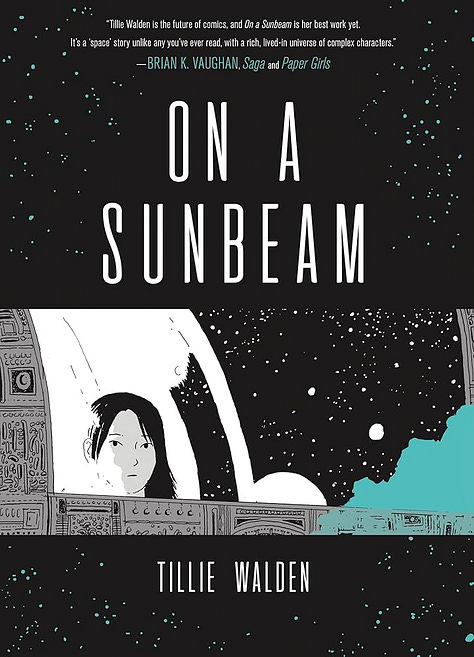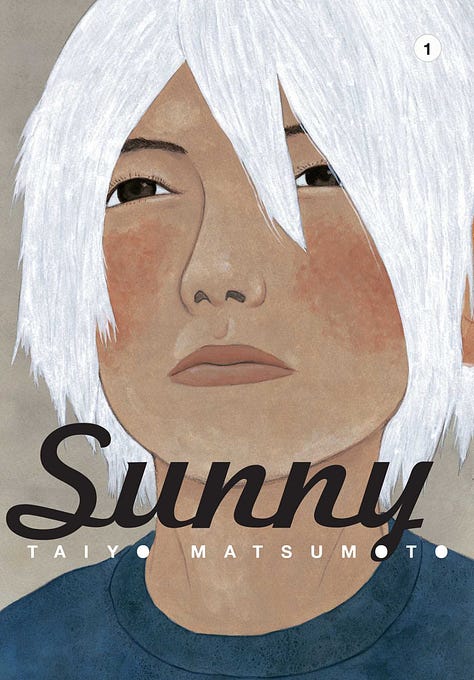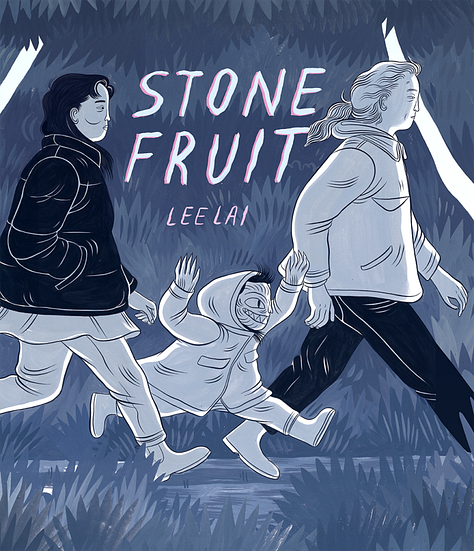Reading Log: Graphic Novels
everyone needs a good healthy collection of graphic novels to get lost in
*Because of all the images, this post might get cut off if you are reading it from your email! You can find the full post on substack here if needed*
When I was little, I loved colouring books. I had stacks of them, always colouring outside the lines and experimenting with bold, unexpected combinations. I was captivated by how I could read the images and watch the scenes unfold—both in my mind and on the page.
Growing up, my dad was a stay-at-home parent, which meant he bore the brunt of my endless arts and crafts escapades. In another life, I think he would’ve made a brilliant cartoonist (Dad, it’s never too late). I had this Barbie colouring book I adored, and while I filled in their Malibu beach-themed adventures, he’d add big, hairy feet to complete the scene. For some reason, Barbie colouring books never included feet—the outlines always stopped at the ankles, even though there was plenty of page space left. It became this wonderful collaborative process: he’d “upgrade” the drawings, and I’d invent stories to go with them. At the time, I thought his creative liberties were ridiculous, but now I look back on those memories with a deep fondness. We’d draw together on colouring books, newspapers, scrap paper—anything we could find. Now, he’s considering writing a memoir, and I’m determined to convince him to illustrate it, too.
The leap from colouring books to graphic novels is one that’s followed me naturally through life. As someone who has always had a flair for the arts, I am incredibly jealous of illustrators and fine artists. This isn’t me being humble, I can be alright at drawing certain things, but not in the way I want. I am much more of a writer, and that’s okay! So to fill the hole inside me that I can’t satiate with my own doodles, I now fill with piles of beautiful graphic novels, picture books, and comic books.
I’ve always been drawn to illustrated books, ever since I was young when my favourite book was Goodnight Moon by Margaret Wise Brown, or when my uncle gifted me his childhood copy of Alice in Wonderland, complete with its enchanting line-work illustrations. That book opened up a whole new world for me, one I’ve never really left behind.
In 2025, the first two graphic novels I have read so far are The Moth Keeper by K. O’Neill and Are You Listening? by Tillie Walden. And let’s just say, it’s a strong start.
I wasn’t familiar with K. O’Neill at first, but as I researched them more, I realized I did know their work. The print pictured below hung on my wall in 2019—I’m pretty sure I picked it up at VanCAF (Vancouver Comic Arts Festival), which means I must have met them there. O’Neill is an illustrator and writer from New Zealand behind beloved graphic novels like The Tea Dragon Society, Princess Princess Ever After, and the upcoming A Song for You and I. I adore their art style; it is very playful and sweet, with a dreamlike quality that highlights a charming nostalgic sentiment.
Now, Tillie Walden is someone I’m much more familiar with. A few years ago, a friend introduced me to On a Sunbeam, which remains one of my favourite books to this day—and I mean favourite across all genres. It’s a beautiful masterpiece, I could talk about this book for hours. It follows an all-female and non-binary cast, with a protagonist who, alongside her new friends, repairs crumbling buildings and ships in outer space. A truly incredible premise! I read a wonderful article that perfectly captured its essence: “It’s a credit to the storytelling that the question of what the book is trying to say by not including men is among the least interesting questions it poses.” (You can read more from the article here.) Walden is a master at crafting these lush, dreamlike fantasy and sci-fi worlds that often mirror the emotional landscapes of her characters. Her work is deeply atmospheric, the kind you can easily lose yourself in, page after page. And we all know how much I love an atmospheric, dream-state reality. Walden’s creations are some of my greatest inspirations for my own writing—the colours, the worlds, the emotional and physical journeys her characters traverse. Her work is poignant in a way that’s difficult to master.
I’m always happy to talk about graphic novels. Honestly, I’m surprised it has taken me this long. If you ever need recommendations, my all-time favourites are On a Sunbeam by Tillie Walden (honestly, anything by her), Sunny by Taiyō Matsumoto, and Stone Fruit by Lee Lai. While each has an incredibly distinct and captivating art style, I’ve found I gravitate toward graphic novels that share similar themes. These three works (and the two that I am about to review) all explore found family and the importance of relationships, isolation and connection, and queer perspectives—whether through gender identity or a broader sense of otherness—all woven together through atmospheric storytelling, a focus on everyday moments, and quiet, introspective narratives. I hadn’t realized my tastes were so specific, and now I’m chuckling to myself.



Don’t get me wrong—as a writer myself, I think literature excels at being atmospheric and gripping. But there’s something about how graphic novelists master the space of the page to evoke emotion that I find truly remarkable. Often, it’s the simplest pages—those with minimal detail or sparse dialogue—that feel the most isolating and captivating in the best way. Maybe my fascination is because these graphic novels rely so heavily on dialogue, which happens to be my weakest skill as a writer. Or maybe it’s just the magic of the medium. Either way, it’s an art form for a reason, and one I deeply admire.
Now enough gushing! Let’s dig into the books I actually said I would talk about today.
The Moth Keeper by K. O’Neill
summary: The Moth Keeper by K. O'Neill is a luminous, kindhearted tale that feels like a warm embrace on a starry night. Set in a desert village where these creatures live only under the moon, the story follows Anya, a young Moth Keeper tasked with protecting the magical moths that pollinate the night-blooming orchards—the lifeblood of her community. But as Anya grows weary of her solitary duties and yearns for the daylight she’s never known, she begins to question her solitary role and the sacrifices it demands. O'Neill’s signature whimsical art style and gentle storytelling weave a heartfelt exploration of belonging, responsibility, and the quiet courage it takes to step into the unknown.
In this world, there are creatures that thrive in the daylight and others that live under the moonlight. The book begins with a folktale about the moon spirit, who spent every night alone in the dark until the sound of its tears moved a small quail to rally other creatures to explore the beauty of the nighttime. This act of courage and connection sets the stage for a world where the sun village and the moon village exist in harmony, each romanticizing the other’s way of life. Though they never meet, their lives are deeply intertwined, working and living symbiotically to sustain their shared world. The sun villagers dream of the cool, quiet mystery of the night, while the moon villagers long for the warmth and vibrancy of the day. It’s a poignant reminder of how we often idealize what we don’t have, even as we depend on one another in ways we might not always see.
At its heart, The Moth Keeper is a story about finding light in the darkness—both literally and metaphorically. It’s about the importance of community, the relationships we build, and the quiet strength it takes to fulfill our roles, even when they feel isolating. K. O’Neill’s tender storytelling and whimsical art left me with that bittersweet ache of wanting to linger in its world just a little longer. It’s a book that reminds us that even in the darkest moments, we’re never truly alone.
While I know that The Moth Keeper is aimed at a middle-grade audience, I found the dialogue to be a bit weaker at times, and there were moments when the illustrations and text didn’t quite sync up seamlessly for me. That said, the art style carries the story beautifully, and I deeply admire O’Neill’s dedication to inspiration and research. The sketches and additional information included at the back of the book were fascinating to peruse, offering a glimpse into the creative process. O’Neill drew inspiration from the breathtaking landscapes of Tongariro National Park and Kā Tiritiri o te Moana (southern alps) in Aotearoa New Zealand, as well as from a rare species of moth. These elements come together to create a world that feels both magical and grounded in the natural beauty of our own world while exploring the highly specialized relationships between flora and fauna.
Are You Listening? by Tillie Walden
summary: Are You Listening? by Tillie Walden is a hauntingly beautiful road trip through a surreal, dreamlike Texas, where the lines between reality and fantasy blur in the most mesmerizing way. The story follows Bea, a young woman running from her past, and Lou, a mysterious drifter with secrets of her own. When the two team up for an impromptu journey, they find themselves navigating not just the open road but a strange, magical landscape filled with eerie towns, otherworldly creatures, and a cat that might just hold the key to everything. Walden’s atmospheric storytelling and soft, flowing art style create a sense of unease and wonder, pulling you into a world that feels both familiar and utterly alien. At its core, it’s a story about healing, connection, and the courage it takes to confront the things we’re running from. It’s the kind of book that lingers in your mind long after you’ve turned the last page, like a half-remembered dream you can’t quite shake.
I can’t speak highly enough of Tillie Walden and her body of work. While Are You Listening? hasn’t quite surpassed On a Sunbeam for me, it’s still a phenomenal piece of storytelling. Reading it feels like traversing the landscape of someone’s dreams, where the dialogue and the absurd, shifting surroundings reveal the characters’ mental and emotional states in subtle, profound ways. It’s surreal, mysterious, haunting, and utterly stunning—a testament to Walden’s ability to craft worlds that feel both deeply personal and expansively universal. Her work continues to leave me in awe and the colour palette is just gorgeous.
A beautiful depiction of found family and the quiet, grounding presence of a guiding figure in your life, this book explores the ways Bea and Lou need each other—most of which are reasons they aren’t yet ready to fully acknowledge or accept. Their journey is as much about the open road as it is about the emotional landscapes they navigate together. What I love most about this book is how it trusts the reader, inviting us to fall effortlessly into its winding, dreamlike road trip. There’s no hand-holding, no over-explaining—just a surreal, immersive experience that feels like stepping into someone else’s subconscious. It’s a story that sticks with you, not just for its haunting beauty but for the way it captures the messy, tender process of healing and connection and how we cope on those darker days.
I think it is an important read for anyone who has gone through, or is going through a hard time. It isn’t a lighthearted or easy read, rather it covers some serious topics that are quite heartbreaking (so be forewarned), but I think it beautifully depicts the importance of connection and how we care for others.
Conclusions
The photos I took of these books don’t do them justice—they’re truly something you need to experience for yourself. While both The Moth Keeper and Are You Listening? explore themes of connection, healing, and found family, they approach storytelling in very different ways. O’Neill’s work, though whimsical and filled with animal-like creatures, feels more traditional in its structure and pacing. It’s gentle, linear, and accessible, perfectly suited for its younger audience. Walden’s work, on the other hand, experiments with the page in ways that feel fragmented and dreamlike, playing with memory and perception to create a narrative that’s as much about feeling as it is about plot. Her stories delve into darker, more complex themes, making them resonate deeply with older readers. Both books are beautiful in their own right, but they offer distinct experiences—one a comforting, luminous fable, the other a haunting, introspective journey. I highly recommend picking them up and seeing for yourself how graphic novels can push boundaries and touch hearts in such unique ways.
Thanks for reading!
xx,
Ciara














Hmm i dont remember saying sorry for ruining your colouring books "woops sorry" hey but some things are nice to remember, sharing art no matter what we draw somehow get to linger in our memories forever. However art comes in many forms & sometimes the littlest things count.
thanks for the memories.
Have you heard of or read Stitches by David Small? It’s a graphic novel that is a memoir and sounds like a horror story!! Right up your alley!